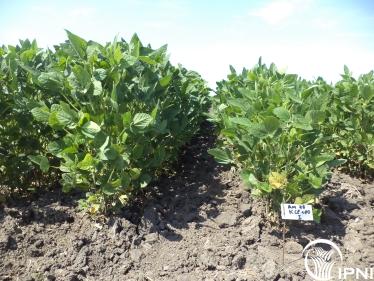A review of phosphorus fertilization in soybean in Argentina
 Response to P in soybean
Response to P in soybean
Phosporus (P) is one of the most common deficient nutrients in soils of Argentina for soybean (Glycine max L. Merril.) grain production. Yield response to P fertilization depends on multiple factors including both, crop and soil characteristics. General patterns of fertilizer response are difficult to derive from single experiments. In this sense, systematic review and meta-analysis of large datasets are useful for studying and summarizing these patterns. For this purpose, on-going research evaluates data from 436 experiments of P response in soybean [Glycine max (L.) Merr.]. This collection of experiments, performed between 971 and 2014 cropping seasons, cover a wide area of Argentina (from 26° 18’ to 38° 33’ S and 57° 32’ to 65° 25’ W; Fig. 1), including different soil types (Vertisolls, Argiudolls, Argialbolls, Argiustolls, Hapludolls, Haplustolls and Entisolls), and weather conditions (from >900 mm y-1 to <600 mm y-1). Experiments included in the database meet the following criteria:
- Treatments include at least a check (non-fertilized) and a fertilized treatment.
- A minimum of 2 replicates per treatment.
- Details of fertilizer management (rate, source, moment, and place)
- A soil-test value (STV) of Bray-1 P.
- Additional (non-exclusive) data included: soil characteristics (soil type, soil carbon, pH, soil texture), rainfall (quantity and distribution), crop management (genotype, crop density, planting date) and details of statistical design.
Most of the experiments come from the so-called “grey literature”, i.e. (non-published on peer-review journals). In many cases, researchers who conducted these experiments were asked to meet the minimum data requirements. Most sources of data were:
- Internal reports of INTA (National Institute of Agriculture Technology), CREA (Regional Consortium of Agriculture Experiments), and FERTILIZAR Civil Association.
- Agronomy magazines (without peer-review process)
- Proceedings of Congresses and/or Symposia.
- Peer-review journals (Agron. J, SSSAJ, Argentina Soil Science Journal)
- Undergraduate and graduate thesis
- Relevant non-published experiments from public and private sector.
Database were built-up and managed with Microsoft® Excel due to its flexibility to import and export data. Data was analyzed by using descriptive statistics and regression analysis. Critical soil test values (CSTV) were estimated by a modification (Correndo et al., 2016) of the Arcsine Logarithm Calibration Curve approach (Dyson & Conyers, 2013).
Figure 1. Geographic distribution of P trials in soybean in Argentina performed between 1971 and 2014 cropping seasons.
PRELIMINARY RESULTS
Relative yield (% of maximum yield in each experiment) was associated with Bray-1 P level. Estimated CSTVs did not show consistent differences between soil types for soybean (Fig. 2). The global CSTV was 9.9 mg kg-1, with a confidence interval between 9.2 and 10.7 mg kg-1. Soybean yield response to P ranged from -1636 to +3233 kg ha-1, with agronomic efficiencies (PAE) ranging from -182 to +234 kg soybean kg P-1. Soil test value of P explained most of variation of yield response and PAE also showed different distributions for the different P rate groups (Fig. 3). Considering three different classes of Bray-1 P level (low, medium and high), STV lower than 10 mg kg-1 and higher than 15 mg kg-1, respectively, showed the highest and the lowest probability to obtain a PAE superior than historical prices ratios (Fig. 4).
Figure 2. Relationship between relative yield (RY, %) and soil Bray-1 P level in the top-soil (0-20 cm) for soybean. A single function was fit for all soil types in soybean (r = 0.36). Data from 436 experiments of P fertilization in soybean in Argentina. Adapted from Correndo et al. (2015).
Figure 4. Cumulative relative frequency of PAE (%) in soybean for different levels of Bray-1 P in the top-soil (0-20 cm) for three ranges of P rate. Grey strips represent the range between percentiles 25% and 75% of historical prices ratio (kg grain kg P-1) in Argentina. Data from 436 experiments of P fertilization in soybean in Argentina.
PRELIMINARY CONCLUSIONS AND PERSPECTIVES
Yield response to P and PAE showed relationships with Bray-1 P level and P rate. The analysis of differences in CSTV, yield response and PAE between different soil types require further steps to make solid conclusions. The analysis of within and between experiments variability (meta-analysis) is the next phase of this project.
ACKNOWLEDGEMENTS
The authors are thankful to many researchers from public and private institutions that have shared their data and greatly helped in the development of this project.
REFERENCES
Correndo, A.A., F. Salvagiotti, F.H. Gutiérrez Boem, & F.O. García. 2015. A review: Yield response to nitrogen and
phosphorus of maize and soybean in argentine pampas. ASA-CSSA-SSSA International Annual Meetings. Nov. 15
to 18th, 2015. Minneapolis, MN, USA. https://scisoc.confex.com/scisoc/2015am/webprogram/Paper92428.html
Correndo, A.A., F.H. Gutiérrez Boem, F. Salvagiotti, & F.O. García. 2016. Método alternativo para estimar niveles críticos de nutrientes. XXV Congreso Argentino de la Ciencia del Suelo. Ordenamiento territorial: un desafío para la ciencia del suelo. 27 de Junio al 1ro. de Julio de 2016. Río Cuarto, Córdoba, Argentina. AACS.
Dyson, C.B., & M.K. Conyers. 2013. Methodology for online biometric analysis of soil test-crop response datasets. Crop & Pasture Science 64, 435-441.
Additional Resources
Preliminary results of project on P calibration in soybeanSize: 2.17 MB
